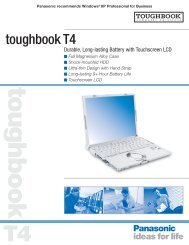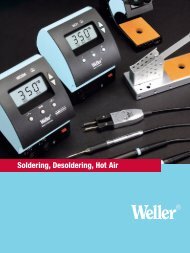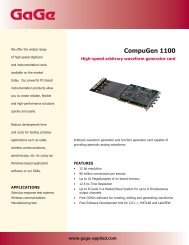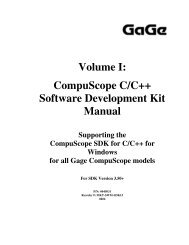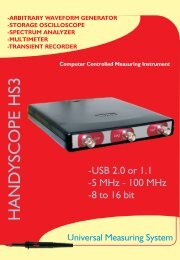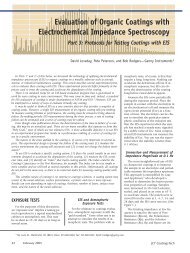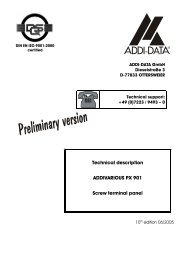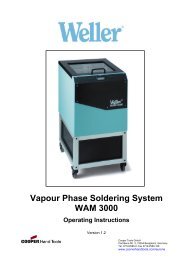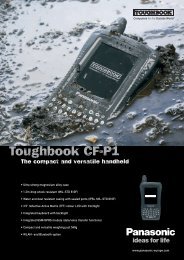CompuScope SDK for M.. - Egmont Instruments
CompuScope SDK for M.. - Egmont Instruments
CompuScope SDK for M.. - Egmont Instruments
You also want an ePaper? Increase the reach of your titles
YUMPU automatically turns print PDFs into web optimized ePapers that Google loves.
<strong>CompuScope</strong> Software Development Kit<br />
(<strong>SDK</strong>) <strong>for</strong> MATLAB<br />
<strong>for</strong> Windows<br />
User’s Guide<br />
<strong>CompuScope</strong> Driver Version 4.10+<br />
For MATLAB 6.5+<br />
P/N: 0045119<br />
Reorder #: MKT-SWM-CSML08<br />
0603
© Copyright Gage Applied Technologies 2005, 2006<br />
Eighth Edition (March 2006)<br />
COMPUSCOPE, GAGESCOPE, AND COMPUGEN are trademarks or registered trademarks of Gage<br />
Applied Technologies.<br />
MICROSOFT WINDOWS, WINDOWS 2000, and WINDOWS XP are registered trademarks of Microsoft<br />
Corporation.<br />
MATLAB is a registered trademark of The MathWorks Inc.<br />
Other company and product names mentioned herein may be trademarks or trade names of their<br />
respective owners.<br />
Changes are periodically made to the in<strong>for</strong>mation herein; these changes will be incorporated into<br />
new editions of the publication. Gage Applied Technologies may make improvements and/or<br />
changes in the products described in this publication at any time.<br />
Copyright © 2005, 2006 Gage Applied Technologies. All Rights Reserved, including those to<br />
reproduce this publication or parts thereof in any <strong>for</strong>m without permission in writing from Gage<br />
Applied Technologies.<br />
How to reach GaGe Product Support<br />
Toll-free phone: (800) 567-4243<br />
Toll-free fax: (800) 780-8411<br />
To reach GaGe Product Support from outside North America<br />
Tel: +1-514-633-7447<br />
Fax: +1-514-633-0770<br />
E-mail: prodinfo@gage-applied.com<br />
Web site: http://www.gage-applied.com<br />
On-line Support Request Form: www.gage-applied.com/support/support_<strong>for</strong>m.php
Table of Contents<br />
PREFACE........................................................................................................................................................4<br />
CHAPTER 1: INSTALLATION OF COMPUSCOPE MATLAB <strong>SDK</strong>.....................................................5<br />
CHAPTER 2: OVERVIEW OF COMPUSCOPE MATLAB <strong>SDK</strong>.............................................................6<br />
OVERVIEW OF COMPUSCOPE MAIN M FILES................................................................................................8<br />
OVERVIEW OF COMPUSCOPE CSML M FILES ..............................................................................................9<br />
CHAPTER 3: DETAILED DESCRIPTION OF COMPUSCOPE MAIN M FILES ...............................10<br />
Setup.m:.................................................................................................................................................10<br />
GageSimple.m: .....................................................................................................................................11<br />
GageAcquire.m .....................................................................................................................................12<br />
GageCoerce.m......................................................................................................................................13<br />
GageMultipleRecord.m ........................................................................................................................13<br />
GageDeepAcquisition.m......................................................................................................................14<br />
GageComplexTriggerAcquire.m.........................................................................................................14<br />
GageMultipleSystems.m:.....................................................................................................................15<br />
DisplayData.m.......................................................................................................................................15<br />
ReadMrDataFiles.m .............................................................................................................................15<br />
Digital Input <strong>CompuScope</strong> cards........................................................................................................15<br />
Advanced Main M files.........................................................................................................................16<br />
CHAPTER 4: OVERVIEW OF CSML M FILES...............................................................................17<br />
CHAPTER 5: SPECIAL TOPICS.....................................................................................................20<br />
Converting from <strong>CompuScope</strong> ADC Code to Voltages ..................................................................20<br />
Depth and Segment Size.....................................................................................................................20<br />
Trigger Holdoff.......................................................................................................................................21<br />
Trigger Delay.........................................................................................................................................21<br />
<strong>CompuScope</strong> Acquisition Timing Diagram .......................................................................................22<br />
Representative Acquisition Sequences.............................................................................................23<br />
TECHNICAL SUPPORT .............................................................................................................................24<br />
GAGE PRODUCTS......................................................................................................................................25<br />
<strong>CompuScope</strong> <strong>SDK</strong> <strong>for</strong> MATLAB <strong>for</strong> Windows 3
Preface<br />
This manual is meant to serve as an aid to engineers using the <strong>CompuScope</strong> series of<br />
high-per<strong>for</strong>mance data acquisition cards in the MATLAB 6.5+ <strong>for</strong> Windows environment.<br />
The <strong>CompuScope</strong> <strong>SDK</strong> <strong>for</strong> MATLAB <strong>for</strong> Windows supports all GaGe <strong>CompuScope</strong> cards<br />
– PCI and CompactPCI/PXI. Specific hardware features that are available in the <strong>SDK</strong><br />
sample programs, however, may not be supported by your <strong>CompuScope</strong> model. Please<br />
refer to the <strong>CompuScope</strong> Hardware Manual <strong>for</strong> in<strong>for</strong>mation specific to your <strong>CompuScope</strong><br />
card in order to determine the capabilities of your <strong>CompuScope</strong> model.<br />
Throughout this manual, it is assumed that you are familiar with the MATLAB<br />
programming environment. If you do not feel com<strong>for</strong>table with MATLAB, it is highly<br />
recommended that you go through the Getting Started with MATLAB ® manual supplied to<br />
you by The MathWorks, Inc. be<strong>for</strong>e starting any program development <strong>for</strong> the<br />
<strong>CompuScope</strong> cards.<br />
It is also assumed that you are familiar with PCs and Microsoft Windows and that you<br />
have correctly installed the <strong>CompuScope</strong> Windows drivers.<br />
This manual will use the terms “<strong>CompuScope</strong> <strong>SDK</strong> <strong>for</strong> MATLAB <strong>for</strong> Windows” and<br />
“<strong>CompuScope</strong> MATLAB <strong>SDK</strong>” interchangeably.<br />
Please note that this manual is not intended as a reference <strong>for</strong> any software other than<br />
the <strong>CompuScope</strong> <strong>SDK</strong>s <strong>for</strong> MATLAB <strong>for</strong> Windows. If you did not receive the correct<br />
guide, please contact the factory <strong>for</strong> a replacement.<br />
To maintain the accuracy of the in<strong>for</strong>mation contained herein, we reserve the right to<br />
make changes to this manual from time to time.<br />
4 <strong>CompuScope</strong> <strong>SDK</strong> <strong>for</strong> MATLAB <strong>for</strong> Windows
Chapter 1: Installation of <strong>CompuScope</strong> MATLAB <strong>SDK</strong><br />
If you purchased the <strong>CompuScope</strong> MATLAB <strong>SDK</strong> you will have been shipped a software<br />
key that allows installation of the <strong>SDK</strong> from the GaGe <strong>CompuScope</strong> CD. Simply select<br />
the installation of the <strong>CompuScope</strong> MATLAB <strong>SDK</strong> from the <strong>CompuScope</strong> CD and enter<br />
the software key when prompted.<br />
By default, the <strong>CompuScope</strong> MATLAB <strong>SDK</strong> will install itself in:<br />
O/S system drive:\Program Files\Gage\<strong>CompuScope</strong>\<strong>CompuScope</strong> MATLAB <strong>SDK</strong>. It is<br />
recommended that you use the default installation location. The <strong>CompuScope</strong> MATLAB<br />
<strong>SDK</strong> will create three sub-folders called Main, CsMl and Adv. These folders respectively<br />
contain Main M file programming examples, CsMl M files that are the building block<br />
function calls from which the Main M files are constructed and advanced M files <strong>for</strong><br />
special non-standard <strong>CompuScope</strong> functionality.<br />
If you require more detailed installation instructions, please refer to the GaGe<br />
<strong>CompuScope</strong> Startup Guide, which was shipped with your order.<br />
Please note, if you had MATLAB installed when you installed the <strong>CompuScope</strong> MATLAB<br />
<strong>SDK</strong>, then the required path settings will be automatically updated upon installation of the<br />
<strong>SDK</strong>. If, however, if you did not have MATLAB installed when you installed the<br />
<strong>CompuScope</strong> MATLAB <strong>SDK</strong>, then you must update the MATLAB path settings manually<br />
after installation of MATLAB. To do this, append AddPath.m to Startup.m in the MATLAB<br />
directory. If Startup.m does not exist, copy AddPath.m into the MATLAB directory and<br />
change the filename to Startup.m. AddPath.m is installed within the Main MATLAB folder<br />
of the MATLAB <strong>SDK</strong><br />
<strong>CompuScope</strong> <strong>SDK</strong> <strong>for</strong> MATLAB <strong>for</strong> Windows 5
Chapter 2: Overview of <strong>CompuScope</strong> MATLAB <strong>SDK</strong><br />
Structure of <strong>CompuScope</strong> MATLAB <strong>SDK</strong><br />
The overall structure of the <strong>CompuScope</strong> MATLAB <strong>SDK</strong> and its relation to the GaGe<br />
<strong>CompuScope</strong> Hardware is best described from the bottom up with reference to the<br />
diagram below.<br />
Main MATLAB <strong>SDK</strong><br />
M File<br />
CsMl<br />
M File<br />
CsMl.DLL<br />
CSSSM.DLL<br />
Windows Application Level<br />
-------------------------------------------------------------------------------------------------------<br />
Windows Kernel Level<br />
GaGe <strong>CompuScope</strong> drivers<br />
GaGe <strong>CompuScope</strong> Hardware<br />
At the lowest level is the <strong>CompuScope</strong> hardware, which is installed within a slot that is<br />
connected to the host PC. The <strong>CompuScope</strong> hardware is directly controlled by the<br />
<strong>CompuScope</strong> Windows drivers. The drivers reside at the Windows Kernel level, which<br />
allows direct low-level access to <strong>CompuScope</strong> hardware registers and to physical PC<br />
RAM.<br />
The Kernel-level drivers communicate with Windows Applications through a Dynamically<br />
Linked Library (DLL) called CSSSM.DLL. Communications through CSSSM.DLL use the<br />
<strong>CompuScope</strong> Applications Programming Interface (API), which is the set of C subroutine<br />
calls that allows control of all <strong>CompuScope</strong> functionality.<br />
Above CSSSM.DLL is an intermediate DLL called CsMl.DLL. This DLL contains a single<br />
MATLAB MEX function called CsMl() that is used to control GaGe <strong>CompuScope</strong><br />
hardware from MATLAB. Different index arguments to CsMl() from MATLAB allow<br />
different operations to be per<strong>for</strong>med on the <strong>CompuScope</strong> hardware.<br />
6 <strong>CompuScope</strong> <strong>SDK</strong> <strong>for</strong> MATLAB <strong>for</strong> Windows
For convenience, all subroutine calls to CsMl() are wrapped within CsMl M files with<br />
descriptive names, which makes the MATLAB coding more readable and removes the<br />
requirement of keeping track of the required index values. All CsMl M file names have<br />
the <strong>for</strong>m CsMl_Xxx.m, where Xxx describes its functionality. Most users should find it<br />
unnecessary to modify CsMl M file code so that the CsMl M files become the building<br />
blocks from which users may construct any required MATLAB M files <strong>for</strong> their application.<br />
The Main M files are top-level application M files that can be executed directly under<br />
MATLAB. Each Main MATLAB M file illustrates usage of the <strong>CompuScope</strong> hardware in<br />
different operating modes. Main M files are constructed using calls to CsMl M files.<br />
Users should not attempt to call CsMl M files directly from the MATLAB command line,<br />
since these M files must be called in the correct order in some cases. The Main MATLAB<br />
M files are intended as convenient starting points <strong>for</strong> <strong>CompuScope</strong> users to develop their<br />
own MATLAB applications.<br />
<strong>CompuScope</strong> Systems<br />
A <strong>CompuScope</strong> system is defined as a single <strong>CompuScope</strong> digitizer board or a group of<br />
<strong>CompuScope</strong> boards configured as a Master/Slave <strong>CompuScope</strong> system. A<br />
Master/Slave <strong>CompuScope</strong> system samples and triggers simultaneously on all channels<br />
and is considered to be one multi-channel <strong>CompuScope</strong> system. For instance, a<br />
Master/Slave system composed of four <strong>CompuScope</strong> two-channel boards will be<br />
considered as a single <strong>CompuScope</strong> system with eight available input channels.<br />
By structuring the drivers to consider <strong>CompuScope</strong> systems, a single PC can be<br />
equipped with almost any imaginable combinations of <strong>CompuScope</strong> hardware. For<br />
instance, a PC could be equipped with two separate Master/Slave systems of four<br />
channels each and then an additional single <strong>CompuScope</strong> system <strong>for</strong> a total of three<br />
<strong>CompuScope</strong> systems.<br />
<strong>CompuScope</strong> systems are addressed from MATLAB by first acquiring a handle <strong>for</strong> the<br />
system, which is an integer value that uniquely describes the <strong>CompuScope</strong> system. After<br />
usage of the system is complete, the user must release the handle so that it is free <strong>for</strong><br />
usage by other processes. By obtaining handles <strong>for</strong> different systems, a single MATLAB<br />
M file may simultaneously operate different <strong>CompuScope</strong> systems. Alternately, separate<br />
MATLAB M files may operate independently and simultaneously by calling handles <strong>for</strong><br />
separate <strong>CompuScope</strong> systems. Different M files may even access the same hardware<br />
as long as one M file frees the system handle be<strong>for</strong>e the other M file obtains it, since<br />
different applications may not simultaneously access the same <strong>CompuScope</strong> system.<br />
While most Main example M files access only a single <strong>CompuScope</strong> system,<br />
understanding the <strong>CompuScope</strong> system structure easily allows users to extend these<br />
Main M files to multiple system operation.<br />
<strong>CompuScope</strong> <strong>SDK</strong> <strong>for</strong> MATLAB <strong>for</strong> Windows 7
Overview of <strong>CompuScope</strong> Main M files<br />
The Main M files are intended to be convenient starting points around which users can<br />
develop customized MATLAB software <strong>for</strong> their digitizer application. Users can construct<br />
more complex M files themselves by using the existing Main M files as a guide to<br />
combining their functionalities.<br />
The basic algorithm <strong>for</strong> all of the Main M files is the following:<br />
1. Initialize the <strong>CompuScope</strong> driver and the <strong>CompuScope</strong> hardware.<br />
2. Obtain the handle to the first available <strong>CompuScope</strong> system in the PC.<br />
3. Pass the desired configuration settings to the driver with a call to Setup.m<br />
4. Pass the configured settings to the <strong>CompuScope</strong> hardware using the<br />
CsMl_Commit() subroutine.<br />
5. Start the <strong>CompuScope</strong> hardware to digitize data into its on-board memory and<br />
await a trigger event.<br />
6. Continuously check to see if the <strong>CompuScope</strong> hardware has finished capturing<br />
the current record.<br />
7. Download the data of interest from the <strong>CompuScope</strong> hardware to MATLAB array<br />
variables.<br />
8. Store the acquired data to a .DAT ASCII data file.<br />
A list of all <strong>CompuScope</strong> Main M files is given below with a brief description of the<br />
functionalities.<br />
GageSimple.m: A simple M file used to verify correct <strong>CompuScope</strong>, driver and MATLAB<br />
<strong>SDK</strong> operation. No adjustments are possible and default <strong>CompuScope</strong><br />
settings are used.<br />
GageAcquire.m: The simplest M file with full configuration control of <strong>CompuScope</strong><br />
settings that illustrates usage of <strong>CompuScope</strong> Single Record Mode.<br />
An error occurs upon entry of invalid settings.<br />
GageCoerce.m: An M file that is just like GageAcquire.m, except that invalid settings are<br />
coerced to the closest valid values.<br />
GageMultipleRecord.m: An M file that acquires and stores captured records when<br />
operating a <strong>CompuScope</strong> system in Multiple Record Mode.<br />
GageDeepAcquisition.m: An M file that acquires and manages large data captures from<br />
<strong>CompuScope</strong> hardware (> 16 MB).<br />
GageComplexTrigger.m: An M file that illustrates usage of complex triggering using<br />
multiple on-board trigger engines, if available.<br />
GageMultipleSystems.m: An M file that operates two independent <strong>CompuScope</strong><br />
systems, each with their own settings and output .DAT files.<br />
8 <strong>CompuScope</strong> <strong>SDK</strong> <strong>for</strong> MATLAB <strong>for</strong> Windows
DisplayData.m: An M file that plots data from .DAT files acquired in Single Record Mode.<br />
ReadMrDataFiles.m: An M file that plots data from .DAT files acquired in Multiple Record<br />
Mode.<br />
All acquired data are stored in .DAT ASCII data files. These files contain a file header<br />
that is between two lines of minus signs (-). The acquired data are then listed as a single<br />
column of data. Data are stored in volts by default but may alternately be stored as raw<br />
ADC data. The DAT file <strong>for</strong>mat is described in more detail in the documentation provided<br />
with the GaGe File Converter utility, which allows conversion between ASCII DAT files<br />
and GageScope SIG binary files.<br />
Not all possible <strong>CompuScope</strong> operation configurations are covered by the Main M files.<br />
For instance, there is an M file that handles deep acquisitions and an M file that handles<br />
acquisitions from two <strong>CompuScope</strong> systems. However, there is not an M file that handles<br />
deep acquisitions from two <strong>CompuScope</strong> systems. For both these functionalities, the<br />
user must study GageDeepAcquisition.m and GageMultipleSystems.m and then<br />
appropriately combine them to create an M file that meets the requirement.<br />
All Main M files should always be executed in their entirety in order to correctly free<br />
<strong>CompuScope</strong> handles so that other processes will be unable to use them. Locked<br />
handles may be freed from MATLAB, however, by invoking the<br />
CsMl_FreeSystem(handle) command if the handle value is known or by calling<br />
CsMl_FreeAllSystems, which will abort all <strong>CompuScope</strong> operations and free all<br />
<strong>CompuScope</strong> system handles. Finally, locked handles may be freed from outside of<br />
MATLAB by doing a “Refresh” from the <strong>CompuScope</strong> Manager utility after exiting<br />
MATLAB.<br />
Overview of <strong>CompuScope</strong> CsMl M files<br />
All Main M <strong>CompuScope</strong> example files are constructed from CsMl M files, which are<br />
easy-to-use building blocks that wrap function calls to the intermediate CsMl.dll. A<br />
MATLAB user is able to develop a custom MATLAB M file <strong>for</strong> their requirement using only<br />
the CsMl M files, with no modifications to them. All CsMl M files are documented later in<br />
this manual.<br />
All CsMl M files have names of the <strong>for</strong>m CsMl_Xxx.m, where xxx describes the<br />
functionality. The M files may be called with arguments and return values using the<br />
general <strong>for</strong>m:<br />
[return_value1, return_value2,…] = CsMl_Xxx(arg1, arg2,…)<br />
The first argument to the function is usually the handle to the <strong>CompuScope</strong> system being<br />
addressed. Generally, not all available return values need to be included in the call but<br />
will not be assigned unless they are included. Some return values, however are required.<br />
The documentation <strong>for</strong> each call will tell which return values are required and which can<br />
be ignored. Generally speaking, if there is one return value it can be ignored. If there is<br />
more than return value, only the rightmost value can be ignored.<br />
A brief description of any CsMl_Xxx M file may be obtained simply by typing “help<br />
CsMl_Xxx” at the MATLAB command prompt.<br />
<strong>CompuScope</strong> <strong>SDK</strong> <strong>for</strong> MATLAB <strong>for</strong> Windows 9
Chapter 3: Detailed Description of <strong>CompuScope</strong> Main M<br />
files<br />
Setup.m:<br />
Within all Main M file programming examples, values of configuration parameters are<br />
assigned within an M file called Setup.m, which is called by every Main MATLAB M file.<br />
Setup.m is called with an argument of the handle of the <strong>CompuScope</strong> system to be<br />
configured. Next, Setup.m calls CsMl_GetSystemInfo.m to obtain in<strong>for</strong>mation about the<br />
<strong>CompuScope</strong> system.<br />
Setup.m proceeds to assign values <strong>for</strong> the three main parameter sets: the acquisition<br />
parameters, the channel parameters and the trigger parameters. Each parameter set has<br />
its own associated variable structure (acq, chan and trig, respectively) that are used as<br />
arguments by the Configuration M files (CsMl_ConfigureAcquisition.m,<br />
CsMl_ConfigureChannel.m and CsMl_ConfigureTrigger.m, respectively). The<br />
Configuration functions are used to assign parameter values within the <strong>CompuScope</strong><br />
driver. However, the parameter setting values are not actually sent to the <strong>CompuScope</strong><br />
hardware until CsMl_Commit is invoked.<br />
Descriptions of all configuration parameters are listed below. Throughout the parameter<br />
assignments, the CsMl_Translate M file is used. Using a context field, this function<br />
translates descriptive strings into parameter index values <strong>for</strong> convenience and code<br />
readability. For instance, instead of remembering that the <strong>CompuScope</strong> mode index<br />
values <strong>for</strong> “Single”, “Dual”, “Quad” and “Octal” modes are 1, 2, 4 and 8, the user can<br />
simply translate these strings using CsMl_Translate.<br />
If any of the configuration parameters are not assigned, their values will be assigned to<br />
default values by the driver. The Channel field within the chan structure and the Trigger<br />
field within the trig structure, however, are mandatory.<br />
Acquisition Parameters<br />
acq.SampleRate<br />
acq.ExtClock<br />
acq.Mode<br />
acq.SegmentCount<br />
acq.Depth<br />
acq.SegmentSize<br />
acq.TriggerTimeout<br />
acq.TriggerDelay<br />
acq.TriggerHoldoff<br />
acq.TimeStampConfig<br />
The sampling rate in Hz<br />
A flag that activates external clocking when non-zero<br />
The <strong>CompuScope</strong> mode, “Single”, “Dual”, “Quad” or “Octal”<br />
The number of segments to be acquired<br />
The post-trigger depth<br />
The size of memory allocated <strong>for</strong> the segment<br />
The trigger time-out value in microseconds<br />
The trigger delay value in samples<br />
The trigger holdoff value in samples<br />
A flag that, when non-zero, resets the Time-Stamp counter at<br />
the beginning of an acquisition<br />
10 <strong>CompuScope</strong> <strong>SDK</strong> <strong>for</strong> MATLAB <strong>for</strong> Windows
Channel Parameters<br />
The chan variable may be either a structure or an array of structures. MATLAB will<br />
handle them either way. If chan is a structure, it may be referenced as either<br />
chan(1).Channel or chan.Channel. Either way is correct. If chan is an array of<br />
structures, each element contains the structure <strong>for</strong> channel number i, where i begins<br />
at 1.<br />
chan(i).Channel The channel number, beginning with 1<br />
chan(i).Coupling The input coupling (AC or DC)<br />
chan(i).DiffInput A flag that, when non-zero, sets the channel to differential<br />
coupling, if available.<br />
chan(i).InputRange The channel full scale input range in millivolts.<br />
For instance, set to 2000 <strong>for</strong> the +/- 1 Volt input range<br />
chan(i).Impedance The channel terminating input impedance in Ohms<br />
chan(i).DcOffset The channel input DC offset in millivolts<br />
chan(i).DirectAdc A flag that, when non-zero, sets the channel to Direct-to-ADC<br />
input coupling, if available.<br />
Trigger Parameters<br />
The trig variable may be either a structure or an array of structures. MATLAB will<br />
handle them either way. If trig is a structure, it may be referenced as either<br />
trig(1).Trigger or trig.Trigger. Either way is correct. If trig is an array of structures,<br />
each element contains the structure <strong>for</strong> each trigger engine i, where i begins at 1. The<br />
use of the trig variable as an array of structures is illustrated within<br />
GageComplexTrigger.m.<br />
trig.Trigger The trigger engine number, beginning with 1<br />
trig.Slope The trigger slope (Positive or Negative)<br />
trig.Level The trigger level as a percentage (-100 to 100) of the trigger source<br />
input range<br />
trig.Source The trigger source (A Trigger Channel Source (1, 2, …), External or<br />
Disable)<br />
trig.ExtCoupling The input coupling of the external trigger input (AC or DC)<br />
trig.ExtRange The external trigger full scale input range in millivolts.<br />
For instance, set to 10000 <strong>for</strong> the +/- 5 Volt input range<br />
GageSimple.m:<br />
GageSimple.m is not intended as a starting point <strong>for</strong> customer applications but is a simple<br />
test program to confirm correct operation of the <strong>CompuScope</strong> hardware, Windows drivers,<br />
and MATLAB <strong>SDK</strong>.<br />
GageSimple.m grabs the handle to the first available <strong>CompuScope</strong> system and does a<br />
single acquisition using the driver defaults <strong>for</strong> all configuration parameters. The driver<br />
defaults are a set of default configuration parameters that are tailored to each<br />
<strong>CompuScope</strong> hardware model. After acquisition, acquired data <strong>for</strong> Channel 1 are<br />
displayed in a simple MATLAB plot window.<br />
<strong>CompuScope</strong> <strong>SDK</strong> <strong>for</strong> MATLAB <strong>for</strong> Windows 11
This M file operates only on a single <strong>CompuScope</strong> card. In the event of a multi-<br />
<strong>CompuScope</strong> system, the M file only addresses the first card in the first system.<br />
Again, GageSimple.m should only be used to test hardware and software integrity and<br />
should not be developed into a custom application M file, since there are better Main M<br />
files <strong>for</strong> this purpose. Simply check that no errors occurred during execution of<br />
GageSimple.m and that the MATLAB plot displays the expected wave<strong>for</strong>m data in order<br />
to confirm that the MATLAB <strong>SDK</strong> is operating correctly.<br />
GageAcquire.m<br />
GageAcquire.m is the Main M file <strong>for</strong> Single Record capture from a single <strong>CompuScope</strong><br />
system. In the event of a multiple <strong>CompuScope</strong> system, the M file only operates the first<br />
card in the system.<br />
The M file first initializes the drivers using CsMl_Initialize, then obtains the handle to the<br />
first available <strong>CompuScope</strong> system using CsMl_GetSystemInfo. Next, Setup.m is called,<br />
which assigns values to each configuration parameter and passes these values to the<br />
drivers.<br />
After Setup.m, CsMl_Commit is called, which actually passes the parameter values that<br />
have been set in the driver to the <strong>CompuScope</strong> hardware. Invalid settings cause an error<br />
and an error message is displayed. Users who prefer the M file to continue operating<br />
upon invalid setting entry should use GageCoerce.m, which will coerce invalid entries to<br />
valid entries and continue running.<br />
Next, the transfer structure is filled with parameters that will determine how the data are<br />
transferred to MATLAB from <strong>CompuScope</strong> memory after acquisition. Parameters within<br />
the transfer structure are:<br />
transfer.Segment The segment number to transfer, starting from 1;<br />
transfer.Start The point from which to start data transfer. Zero indicates the trigger<br />
address. Enter a negative value in order to download pre-trigger data;<br />
transfer.Length The number of points to transfer, starting from the Start point.<br />
In GageAcquire.m, the transfer length is set equal to the SegmentSize, so that all<br />
segment data are returned. The transfer start is set equal to the Trigger Holdoff, so that<br />
all valid pre-trigger data are transferred. These two values (SegmentSize and Holdoff)<br />
were set previously within Setup.m but are obtained using CsMl_QueryAcquisition.<br />
Next, the acquisition is initiated on the <strong>CompuScope</strong> system using CsMl_Capture. The<br />
<strong>CompuScope</strong> hardware then begins acquiring pre-trigger data and awaiting a trigger<br />
event. The acquisition terminates after the trigger event occurs and the <strong>CompuScope</strong><br />
system has acquired the requested amount of pre-trigger data. The state of the<br />
<strong>CompuScope</strong> system is queried using CsMl_QueryStatus(handle) until the acquisition<br />
has completed.<br />
Once the acquisition is complete, data are transferred to MATLAB using CsMl_Transfer.<br />
Within GageAcquire.m, CsMl_Transfer is configured to first transfer the raw integer ADC<br />
data and then to convert these data to voltage values. These converted voltage values<br />
are then returned by CsMl_Transfer. For faster repetitive capture per<strong>for</strong>mance,<br />
12 <strong>CompuScope</strong> <strong>SDK</strong> <strong>for</strong> MATLAB <strong>for</strong> Windows
CsMl_Transfer may alternately be configured to transfer raw ADC code data as integers.<br />
Mathematical operations may not be per<strong>for</strong>med on these integer values, however, without<br />
first converting them to double values.<br />
After transfer, the data are stored to ASCII DAT files with the appropriate header<br />
in<strong>for</strong>mation. The DAT files have names of the <strong>for</strong>m Acquire_CHx.dat, where x is the<br />
channel number. Wave<strong>for</strong>m data are also displayed in a simple MATLAB plot window.<br />
While GageAcquire.m simply stores and displays wave<strong>for</strong>m data, the end of the program<br />
may be easily modified by the user to instead manage the data according to the<br />
requirements of the application. For instance, wave<strong>for</strong>m data may be immediately<br />
analyzed in real-time using MATLAB’s extensive math libraries.<br />
GageCoerce.m<br />
GageCoerce.m is identical to GageAcquire.m, except that in the event of invalid<br />
configuration setting entries, the M file will not stop with an error message. Instead of<br />
stopping, if invalid configuration settings are entered, the M file will coerce the settings to<br />
values that are available on the current <strong>CompuScope</strong> system. When coercion occurs, a<br />
message is printed which indicates that a parameter was coerced and the current<br />
acquisition, channel, and trigger parameters are printed to the console. Current active<br />
parameter settings may be queried using the Query CsMl files. Wave<strong>for</strong>m data are stored<br />
in DAT files named Coerce_CHx.dat, where x is the channel number.<br />
GageMultipleRecord.m<br />
GageMultipleRecord.m is the Main M file <strong>for</strong> Multiple Record capture from a single<br />
<strong>CompuScope</strong> system. Multiple Record mode allows multiple wave<strong>for</strong>ms to be rapidly<br />
acquired and stacked in on-board <strong>CompuScope</strong> memory. For instance, a <strong>CompuScope</strong><br />
card with 32 MegaSamples of on-board memory may acquire 16,000 records of 2,000<br />
samples each in Multiple Record Mode. (Strictly speaking, depending on the<br />
<strong>CompuScope</strong> model, this relation may not exactly apply because of slight inter-record<br />
padding requirements.)<br />
Between successive acquisitions, the <strong>CompuScope</strong> acquisition engine is re-armed by the<br />
hardware with no CPU interaction required. Consequently, in Multiple Record Mode, a<br />
<strong>CompuScope</strong> card is capable of capturing bursts of trigger that repeat at rates of 100,000<br />
triggers per second and more.<br />
The number of records or segments to acquire is set using the SegmentCount parameter.<br />
This is set to 1 within the single Setup.m file that is provided and so must be raised <strong>for</strong> a<br />
large record count. If SegmentCount exceeds the maximum possible number of records,<br />
which is roughly equal to the available acquisition memory divided by the Depth, then an<br />
error will occur. (If coercion had been used in this case, then the actual number of<br />
records would have been set equal to its maximum possible value.)<br />
The SegmentSize parameter is used to control the size of each Multiple Record segment.<br />
For newer <strong>CompuScope</strong> hardware, this may be set larger than the Depth parameter so<br />
that pre-trigger data may be acquired. Older <strong>CompuScope</strong> models do not support pretrigger<br />
data in Multiple Record Mode. Consequently, setting SegmentSize to a value<br />
different from Depth will cause an error. Please refer to your <strong>CompuScope</strong> Hardware<br />
<strong>CompuScope</strong> <strong>SDK</strong> <strong>for</strong> MATLAB <strong>for</strong> Windows 13
Manual <strong>for</strong> in<strong>for</strong>mation specific to your <strong>CompuScope</strong> model’s capabilities. For a more<br />
detailed discussion of the relationship between SegmentSize and Depth, please see<br />
Chapter 5: Special Topics.<br />
When executed, GageMultipleRecord.m first initializes and configures the <strong>CompuScope</strong><br />
system, as in GageAcquire.m. Next, a single Multiple Record acquisition is per<strong>for</strong>med.<br />
After acquisition, the M file goes into a loop that downloads each Multiple Record from<br />
each active channel and stores the record data to ASCII data files.<br />
Newer <strong>CompuScope</strong> models such as the CS14200, CS14105 and CS12400, support<br />
Time-Stamping. This feature registers an on-board counter value <strong>for</strong> each Multiple<br />
Record trigger event that indicates its time of occurrence. Time 0 is the time at which the<br />
time-stamping counter was last reset. The Time-Stamp counter is reset to zero at the<br />
beginning of GageMultipleRecord.m. If the <strong>CompuScope</strong> system is equipped with onboard<br />
Time-Stamping, GageMultipleRecord.m downloads Time Stamp data and stores<br />
each Time Stamp in the corresponding ASCII DAT file. Otherwise, a 0 is stored as the<br />
Time Stamp value.<br />
GageDeepAcquisition.m<br />
GageDeepAcquisition.m is the Main M file <strong>for</strong> large acquisitions from a single<br />
<strong>CompuScope</strong> system. The definition of large varies with system configuration but is<br />
roughly about 16 MegaBytes. For small acquisitions, MATLAB is fully capable of<br />
downloading the entire acquisition into PC RAM. For larger acquisitions, the host PC will<br />
begin to use “virtual RAM”, which is a section of the hard drive that Windows treats like<br />
PC RAM. Usage of virtual RAM causes the hard drive to spin and slows down execution.<br />
For large enough data sets, MATLAB will simply refuse to download the data at all.<br />
In order to avoid trying to keep large data sets in MATLAB at one time,<br />
GageDeepAcquisition.m manages deep acquisitions by dividing them up into more<br />
manageable data pages, whose size is denoted by the chunksize variable. The M file<br />
does initialization, configuration setting and acquisitions as usual. After the acquisition,<br />
however, data are downloaded in pages of size chunksize. Each page is stored in its own<br />
ASCII DAT file called DeepAcquisition_CHxx-yyyy.dat, where xx is the channel number<br />
and yyyy is the page number. One complete data file <strong>for</strong> the entire acquisition may easily<br />
be created by removing the header <strong>for</strong> each DAT file and combining them in order by<br />
page number.<br />
The user may easily replace data storage with analysis and/or display to suit their<br />
requirements. Users should always use a similar data paging scheme <strong>for</strong> downloading<br />
large amounts of data and should never attempt to download large amounts of data at<br />
one time.<br />
GageComplexTriggerAcquire.m<br />
GageComplexTriggerAcquire.m is a Main M file that illustrates complex triggering. Some<br />
<strong>CompuScope</strong> models are equipped with two on-board trigger engines that can be used<br />
<strong>for</strong> complex triggering. On these models, the two engines can be configured<br />
14 <strong>CompuScope</strong> <strong>SDK</strong> <strong>for</strong> MATLAB <strong>for</strong> Windows
independently and their outputs are Boolean ORed together so that either engine may<br />
cause a trigger event. For simple triggering, the second engine is disabled.<br />
The trig structure array allows the separate configuration of each trigger engine. For<br />
instance, by setting the two engine sources to Channel 1and Channel 2, the user may<br />
configure the system to trigger on a pulse that occurs on either channel. Alternately, by<br />
setting both engine sources to Channel 1 but selecting different levels and slopes <strong>for</strong><br />
each, the user may configure the system to do windowed triggering, where the system<br />
triggers if the input level leaves a specified voltage range.<br />
GageComplexTriggerAcquire.m uses the trig structure as an array, where each element<br />
controls a separate trigger engine. Otherwise, the M file is just like GageAcquire.m.<br />
GageMultipleSystems.m:<br />
GageMultipleSystems.m is the Main M file <strong>for</strong> Multiple Independent <strong>CompuScope</strong><br />
systems. The M file begins by obtaining the number of <strong>CompuScope</strong> systems within the<br />
host PC. It then obtains a handle to each of these systems. The GageMultipleSystems.m<br />
then proceeds to execute the same order of operations as GageAcquire.m, except each<br />
operation is within a loop that successively operates on each <strong>CompuScope</strong> system.<br />
A user can extend the logic illustrated within GageMultipleSystems.m to achieve any<br />
acquisition sequence from Multiple Independent <strong>CompuScope</strong> systems. For instance, the<br />
user may choose to separate the code that controls each <strong>CompuScope</strong> system so that<br />
acquisitions are per<strong>for</strong>med sequentially on each system. Alternately, the user may<br />
choose to do a deep memory acquisition on one system and a Multiple Record acquisition<br />
on another. This is done by appropriately merging GageMultipleRecord.m and<br />
GageDeepAcquisition.m using separate <strong>CompuScope</strong> handles <strong>for</strong> the two code sections.<br />
DisplayData.m<br />
DisplayData.m reads <strong>CompuScope</strong> data from an ASCII DAT file and plots them in a<br />
MATLAB plot window. The M file may be called from within another M file.<br />
ReadMrDataFiles.m<br />
ReadMrDataFiles.m reads <strong>CompuScope</strong> data from an ASCII DAT file created from a<br />
Multiple Record acquisition and plots them in a MATLAB mesh plot. The M file may be<br />
called from within another M file.<br />
Digital Input <strong>CompuScope</strong> cards<br />
All MATLAB <strong>SDK</strong> programs may be used to per<strong>for</strong>m acquisitions from digital input<br />
<strong>CompuScope</strong> cards, such as the CS3200 and CS3200C. Parameters specific to digital<br />
input cards may be set by using the CsMl_ConfigureXxx M files with the appropriate<br />
modifiers. By using these special parameter settings <strong>for</strong> the digital input <strong>CompuScope</strong><br />
cards, a user may operate any one of the Main M files<br />
<strong>CompuScope</strong> <strong>SDK</strong> <strong>for</strong> MATLAB <strong>for</strong> Windows 15
The CS3200 and CS3200C allow three digital input sample width modes <strong>for</strong> optimal<br />
memory usage: 8-bit, 16-bit and 32-bit. These modes may be selected acq.Mode<br />
together with the CsMl_Translate.m within Setup.m and using the following string values:<br />
Single<br />
Dual<br />
Quad<br />
to activate 8-bit digital input mode<br />
to activate 16-bit digital input mode<br />
to activate 32-bit digital input mode<br />
The CS3200 and CS3200C provide different digital input signal level protocols, depending<br />
on the model. Different digital input protocols are selected by setting appropriate values<br />
of chan(i).InputRange within Setup.m and using the following input range values:<br />
2500 to activate CMOS digital voltage levels<br />
1500 to activate TTL digital voltage levels<br />
-2000 to activate ECL digital voltage levels<br />
3000 to activate PECL digital voltage levels<br />
0 to activate LVDS digital voltage levels<br />
The CS3200 and CS3200C allow inversion of the sampling clock so that digital samples<br />
are acquired on the falling edge of the clock signal rather than on the rising edge. In<br />
order to select the falling edge, the desired acq.Mode must be ORed with the<br />
hexadecimal value 0x800. Consequently, strings with the CsMl_Translate.m file may not<br />
be used and acq.Mode must be assigned to the following numerical values: .<br />
2049 to activate 8-bit digital input mode with clock inversion<br />
2050 to activate 16-bit digital input mode with clock inversion<br />
2052 to activate 32-bit digital input mode with clock inversion<br />
Advanced Main M files<br />
The MATLAB <strong>SDK</strong> may contain “Advanced” M files in addition to the documented Main M<br />
files. Usage of some of these files may require special <strong>CompuScope</strong> hardware options,<br />
on-board firmware processing images or a special driver version. These M files are<br />
located in the adv folder and are provided as-is with limited documentation in the <strong>for</strong>m of<br />
an accompanying explanatory text file.<br />
16 <strong>CompuScope</strong> <strong>SDK</strong> <strong>for</strong> MATLAB <strong>for</strong> Windows
Chapter 4: Overview of CsMl M Files<br />
Please refer to the MATLAB <strong>SDK</strong> help <strong>for</strong> a more detailed description of CsMl M file<br />
operation. At the MATLAB command prompt, type “help” and the name of the CsMl<br />
M file. (e.g. help CsMl_AbortCapture)<br />
CsMl_AbortCapture<br />
CsMl_AbortCapture aborts an acquisition on a <strong>CompuScope</strong> system.<br />
CsMl_Capture<br />
CsMl_Capture begins an acquisition using the current acquisition parameters on a<br />
<strong>CompuScope</strong> system.<br />
CsMl_Commit<br />
CsMl_Commit sends the acquisition, channel and trigger parameters that are in the driver<br />
to a <strong>CompuScope</strong> system.<br />
CsMl_ConfigureAcquisition<br />
CsMl_ConfigureAcquisition sets the acquisition parameters <strong>for</strong> a <strong>CompuScope</strong> system.<br />
CsMl_ConfigureChannel<br />
CsMl_ConfigureChannel sets the channel parameters <strong>for</strong> a <strong>CompuScope</strong> system.<br />
CsMl_ConfigureFir<br />
CsMl_ConfigureFir sets the Finite Impulse Response parameters <strong>for</strong> a <strong>CompuScope</strong><br />
system.<br />
Note that the <strong>CompuScope</strong> system must have an optional FIR image available and<br />
loaded <strong>for</strong> this function to work.<br />
CsMl_ConfigureTrigger<br />
CsMl_ConfigureTrigger sets the trigger parameters <strong>for</strong> a <strong>CompuScope</strong> system.<br />
CsMl_ErrorHandler<br />
CsMl_ErrorHandler processes errors from other CsMl_Xxx calls.<br />
CsMl_ForceCapture<br />
CsMl_ForceCapture <strong>for</strong>ces a trigger event to occur on a <strong>CompuScope</strong> system.<br />
<strong>CompuScope</strong> <strong>SDK</strong> <strong>for</strong> MATLAB <strong>for</strong> Windows 17
CsMl_FreeAllSystems<br />
CsMl_FreeAllSystems aborts any acquisitions and frees all <strong>CompuScope</strong> systems that<br />
are currently in use.<br />
CsMl_FreeSystem<br />
CsMl_FreeSystem frees a <strong>CompuScope</strong> system.<br />
Once a system is freed, it may be used by other applications.<br />
CsMl_GetErrorString<br />
CsMl_GetErrorString translates the error code returned by other CsMl_Xxx functions into<br />
a descriptive error message.<br />
CsMl_GetExtendedOptions<br />
Extended options are optional programmed firmware images. CsMl_GetExtendedOptions<br />
returns in<strong>for</strong>mation about the optional programmed firmware images available on a<br />
<strong>CompuScope</strong> system.<br />
CsMl_GetSystem<br />
CsMl_GetSystem returns a handle that uniquely identifies a <strong>CompuScope</strong> system.<br />
CsMl_GetSystemCaps<br />
CsMl_GetSystemCaps returns in<strong>for</strong>mation about the capabilities of a <strong>CompuScope</strong><br />
system. While complicating a MATLAB program, this function may be used to allow the<br />
program to support any possible configuration of <strong>CompuScope</strong> hardware. MATLAB <strong>SDK</strong><br />
Main M files do not use this function.<br />
CsMl_GetSystemCaps<br />
CsMl_GetSystemInfo returns static in<strong>for</strong>mation about a <strong>CompuScope</strong> system.<br />
CsMl_Initialize<br />
CsMl_Initialize initializes a <strong>CompuScope</strong> system and is typically the first <strong>CompuScope</strong><br />
call made in a program.<br />
CsMl_QueryAcquisition<br />
CsMl_QueryAcquisition returns in<strong>for</strong>mation about a <strong>CompuScope</strong> system.<br />
CsMl_QueryChannel<br />
CsMl_QueryChannel returns in<strong>for</strong>mation about the specified channel in a <strong>CompuScope</strong><br />
system.<br />
18 <strong>CompuScope</strong> <strong>SDK</strong> <strong>for</strong> MATLAB <strong>for</strong> Windows
CsMl_QueryStatus<br />
CsMl_QueryStatus queries the driver <strong>for</strong> the current acquisition status of a <strong>CompuScope</strong><br />
system.<br />
CsMl_QueryTrigger<br />
CsMl_QueryTrigger returns in<strong>for</strong>mation about the specified trigger in a <strong>CompuScope</strong><br />
system.<br />
CsMl_ReadDataFile<br />
CsMl_ReadDataFile reads data from ASCII DAT files and adjusts the data to account <strong>for</strong><br />
alignment issues using the Start address and Data length fields saved in the ASCII file<br />
header.<br />
CsMl_ResetTimeStamp<br />
CsMl_ResetTimeStamp resets the time stamp counter associated with a <strong>CompuScope</strong><br />
system.<br />
CsMl_SaveFile<br />
CsMl_SaveFile saves a buffer of data acquired by a <strong>CompuScope</strong> system to an ASCII<br />
DAT file.<br />
CsMl_Transfer<br />
CsMl_Transfer transfers data <strong>for</strong> one channel from a <strong>CompuScope</strong> system<br />
CsMl_Translate<br />
CsMl_Translate is provided <strong>for</strong> convenience and allows conversion of descriptive string<br />
into constant values that are required by the driver, thereby not requiring the user to look<br />
up the values in tables.<br />
<strong>CompuScope</strong> <strong>SDK</strong> <strong>for</strong> MATLAB <strong>for</strong> Windows 19
Chapter 5: Special Topics<br />
Converting from <strong>CompuScope</strong> ADC Code to Voltages<br />
<strong>SDK</strong> sample programs are configured to save or display <strong>CompuScope</strong> wave<strong>for</strong>m data<br />
that have been scaled so that the sample values are in Volts. The user may want to<br />
bypass the voltage conversion step, however, in order to achieve the best repetitive<br />
capture per<strong>for</strong>mance. Voltage conversion may then be done at leisure in postprocessing.<br />
Raw ADC code wave<strong>for</strong>m data may be converted to voltage data <strong>for</strong> all <strong>CompuScope</strong><br />
models using the following equation:<br />
Offset − ADC_Code<br />
Voltage =<br />
×<br />
Resolution<br />
( )<br />
Full Scale Input Voltage<br />
2<br />
+ DC _ Offset<br />
The Offset and Resolution <strong>for</strong> the <strong>CompuScope</strong> system may be obtained<br />
programmatically using various <strong>SDK</strong> tools. The DC offset settings, supported only on<br />
newer <strong>CompuScope</strong> models, must be added.<br />
For instance, <strong>for</strong> the <strong>CompuScope</strong> 82G, Offset=127 and Resolution=128. Let us assume<br />
that the user has selected the +/-1 Volt Input Range, <strong>for</strong> a Full Scale Input Range of<br />
2 Volts. Let us further assume that the user has applied a 200 mV offset. For this<br />
example, there<strong>for</strong>e, the voltage conversion equation becomes:<br />
127 −<br />
Voltage =<br />
ADC_Code<br />
× 1 Volts + 0.2 Volts<br />
128<br />
Depth and Segment Size<br />
On all <strong>CompuScope</strong> models, on-board acquisition memory is arranged as a circular buffer<br />
<strong>for</strong> Single Record acquisitions. This means that when the <strong>CompuScope</strong> is storing<br />
acquired data and it reaches the end of the memory, the memory counter rolls over. Data<br />
storage wraps around the memory and starts digitizing into the beginning of memory. The<br />
end of an acquisition is always initiated by the trigger event, after which the requested<br />
number of post-trigger data points is acquired and then the acquisition terminates. This<br />
circular memory architecture allows the <strong>CompuScope</strong> to accumulate an amount of pretrigger<br />
data of up to the amount of <strong>CompuScope</strong> acquisition memory per channel, less the<br />
amount of post-trigger data.<br />
Newer <strong>CompuScope</strong> models, such as the CS82G, CS12400, CS14200 and CS14105,<br />
allow <strong>for</strong> the accumulation of pre-trigger data in Multiple Record Mode. On these models,<br />
memory is divided into multiple circular buffers, the number of which is equal to the<br />
number of records specified. The Segment Size control allows the user to specify the<br />
size of each circular buffer. This way, the user may select the amount of memory<br />
reserved <strong>for</strong> pre-trigger data accumulation. For instance, if the user selects a post-trigger<br />
Depth of 2048 and a Multiple Record Segment Size of 8192, then up to 6144 Samples of<br />
<strong>CompuScope</strong> <strong>SDK</strong> <strong>for</strong> MATLAB <strong>for</strong> Windows 20
pre-trigger data may be acquired. Increasing the Segment Size beyond the Depth will<br />
accordingly reduce the maximum possible number of Multiple Records.<br />
Only newer <strong>CompuScope</strong> models such as the CS82G, CS12400, CS14200 and<br />
CS14105, support pre-trigger Multiple Record Mode. On older <strong>CompuScope</strong> models<br />
without pre-trigger data in Multiple Record Mode, the Segment Size setting will have no<br />
effect on a Multiple Record acquisition. The value is ignored and is <strong>for</strong>ced to be equal to<br />
the Depth by the drivers.<br />
Trigger Holdoff<br />
Trigger Holdoff is a feature that is useful <strong>for</strong> ensuring the accumulation of a specified<br />
amount of pre-trigger data. The Trigger Holdoff setting specifies the amount of time, in<br />
Samples during which the <strong>CompuScope</strong> hardware will ignore trigger events after<br />
acquisition has begun and pre-trigger data are being acquired.<br />
Without a non-zero Trigger Holdoff value, there is no guarantee that a given number of<br />
pre-trigger samples will be acquired. This is because a trigger event may occur<br />
immediately after acquisition, leading to a very small number of pre-trigger points. By<br />
ignoring trigger events <strong>for</strong> a time equal to the specified Trigger Holdoff value, the<br />
accumulation of a number of pre-trigger points equal to the Trigger Holdoff setting is<br />
guaranteed.<br />
The downside of ensuring pre-trigger data with a non-zero Trigger Holdoff value is that<br />
triggers are ignored, so that important trigger events may be missed. For instance, in<br />
lightning monitoring applications, researchers usually want to acquire pre-trigger data.<br />
These data give in<strong>for</strong>mation about signal behavior immediately preceding the lightning<br />
strike, which triggers the <strong>CompuScope</strong> hardware. Lightning strikes may occur very close<br />
together in time, however, and missing a lightning pulse is much worse than missing pretrigger<br />
data. Consequently, lightning testers should not use Trigger Holdoff but should<br />
simply accept acquisitions of only the amount of pre-trigger data that naturally occur<br />
between triggers. Generally speaking, there<strong>for</strong>e, the user must decide whether to use<br />
Trigger Holdoff, based on the application.<br />
Trigger Delay<br />
New-generation PCI <strong>CompuScope</strong> models such as the CS14200, CS14105 and<br />
CS12400, support a feature called Trigger Delay. This feature is useful <strong>for</strong> situations<br />
where the signal portion of interest occurs long after the trigger event.<br />
Normally, with a Trigger Delay of zero, the trigger event activates count-down of the posttrigger<br />
depth counter, which was preloaded with the post-trigger depth. The counter is<br />
decremented by one count <strong>for</strong> each sample acquired after the trigger event. When the<br />
counter value reaches 0, the acquisition is terminated. In this way, the <strong>CompuScope</strong><br />
acquires a number of samples equal to the depth after the trigger event.<br />
A non-zero Trigger Delay value is used to delay the beginning of the countdown of the<br />
post-trigger depth counter. The Trigger Delay value sets the number of samples that the<br />
<strong>CompuScope</strong> hardware will wait after the trigger event occurs be<strong>for</strong>e beginning the countdown<br />
of the depth counters. The SegmentSize may be set equal to the depth so that the<br />
<strong>CompuScope</strong> <strong>SDK</strong> <strong>for</strong> MATLAB <strong>for</strong> Windows 21
<strong>CompuScope</strong> hardware need not waste memory by storing data that are not of interest.<br />
As an example, consider a signal where the feature of interest is 20,000 samples long but<br />
begins 100,000 samples after the trigger event. In this case, the SegmentSize and Depth<br />
should be set to 20,000. The Trigger Delay value should be set to 100,000. Without the<br />
Trigger Delay feature, the user would be <strong>for</strong>ced to set the Depth to 120,000 Samples and<br />
waste 100,000 Samples of memory, even though only the last 20,000 were downloaded.<br />
Using the Trigger Delay feature, however, only the data of interest are retained in<br />
<strong>CompuScope</strong> memory.<br />
<strong>CompuScope</strong> Acquisition Timing Diagram<br />
The timing diagram below is provided as an aid <strong>for</strong> understanding the timing of events<br />
during the acquisition of a segment or record. The pseudo—signals are indicated as<br />
HIGH when the labeled function is active.<br />
A <strong>CompuScope</strong> system always acquires from the beginning of the Segment Start pulse<br />
and continues until the Depth counter’s count-down has expired. The memory allotted to<br />
the acquisition is equal to the Segment Size and is arranged in a circular fashion. Notice<br />
that raw trigger events are ignored until the Trigger Holdoff time has elapsed.<br />
Note also that, although pre-trigger data are acquired throughout the time between<br />
Segment Start and the Trigger Event, most of the acquired pre-trigger data have been<br />
overwritten in the diagram below and only a small fraction are available <strong>for</strong> download.<br />
22 <strong>CompuScope</strong> <strong>SDK</strong> <strong>for</strong> MATLAB <strong>for</strong> Windows
Representative Acquisition Sequences<br />
The diagram below illustrates important representative acquisition sequences that are<br />
presented <strong>for</strong> key acquisition requirements. The first sequence shows a generalized<br />
acquisition with data collected during all acquisitions phases illustrated: overwritten pretrigger<br />
data, available pre-trigger data, data acquired during the Trigger Delay and posttrigger<br />
data.<br />
The second sequence shows an acquisition using a trigger delay where the Segment<br />
Size is made equal to the Depth. This acquisition sequence is useful <strong>for</strong> applications<br />
where the signal region of interest occurs long after the trigger event, as is often the case<br />
<strong>for</strong> Time Domain Reflectometry methods such as ultrasonics, radar and lidar.<br />
The third sequence shows the acquisition in the case of a rapidly occurring trigger. In this<br />
case, the Segment size has been set bigger than the Depth. However, the trigger event<br />
occurred so rapidly after the start of the acquisitions that there was insufficient time to fill<br />
all of the memory allotted <strong>for</strong> pre-trigger data, which is (Segment Size – Depth) samples.<br />
Consequently, there is less preceding valid trigger data than the maximum possible<br />
amount of pre-trigger data. If transfer of invalid data were requested, the driver would<br />
return an actual start address that is equal to the address of the first valid pre-trigger<br />
point. More pre-trigger data could have been acquired using Trigger Holdoff at the<br />
expense ignoring (and so possibly missing) triggers.<br />
The final sequence shows acquisition in the case of a trigger that occurs long after<br />
Segment Start so that all memory allotted <strong>for</strong> pre-trigger data has been filled up. In fact,<br />
the sequence shows that still more pre-trigger data were acquired but were overwritten by<br />
post-trigger data.<br />
<strong>CompuScope</strong> <strong>SDK</strong> <strong>for</strong> MATLAB <strong>for</strong> Windows 23
Technical Support<br />
We offer technical support <strong>for</strong> all our Software Development Kits.<br />
In order to serve you better, we have created a web-based technical support system that is<br />
available to you 24 hours a day.<br />
By utilizing the internet to the fullest, we are able to provide you better than ever technical support<br />
without increasing our costs, thereby allowing us to provide you the best possible product at the<br />
lowest possible price.<br />
To obtain technical support, simply visit:<br />
www.gage-applied.com/support/support_<strong>for</strong>m.php<br />
Please complete this <strong>for</strong>m and submit it. Our <strong>for</strong>m processing system will intelligently route your<br />
request to the Technical Support Specialist (TSS) most familiar with the intricacies of your product.<br />
This TSS will be in contact with you within 24 hours of <strong>for</strong>m submittal.<br />
In the odd case that you have problems submitting the <strong>for</strong>m on our web site, please e-mail us at<br />
tech-support@gage-applied.com<br />
As opposed to automatic routing of technical support requests originating from the GaGe web site,<br />
support requests received via e-mail or telephone calls are routed manually by our staff. Providing<br />
you with high quality support may take an average of 2 to 3 days if you do not use the web-based<br />
technical support system.<br />
Please note that Technical Support Requests received<br />
via e-mail or by telephone will take an average of 2 to 3 days to process.<br />
It is faster to use the web site!<br />
When calling <strong>for</strong> support we ask that you have the following in<strong>for</strong>mation available:<br />
1. Version and type of your <strong>CompuScope</strong> <strong>SDK</strong> and drivers.<br />
(The version numbers are indicated in the About CD screen of the <strong>CompuScope</strong> CD.<br />
Version numbers can also be obtained by looking in the appropriate README.TXT files)<br />
2. Type, version and memory depth of your <strong>CompuScope</strong> card.<br />
3. Type and version of your operating system.<br />
4. Type and speed of your computer and bus.<br />
5. If possible, the file saved from the In<strong>for</strong>mation tab of the <strong>CompuScope</strong> Manager utility.<br />
6. Any extra hardware peripherals (i.e. CD-ROM, joystick, network card, etc.)<br />
7. Were you able to reproduce the problem with standalone GaGe Software (e.g. GageScope,<br />
GageBit)?<br />
<strong>CompuScope</strong> <strong>SDK</strong> <strong>for</strong> MATLAB <strong>for</strong> Windows 24
GaGe Products<br />
For ordering in<strong>for</strong>mation, see Gage’s product catalog, or visit our web site at<br />
http://www.gage-applied.com<br />
CompactPCI Bus Products <strong>CompuScope</strong> 82GC 8 bit, 2 GS/s Analog Input Card<br />
<strong>CompuScope</strong> 14100C<br />
14 bit, 100 MS/s Analog Input Card<br />
<strong>CompuScope</strong> 1610C<br />
16 bit, 10 MS/s Analog Input Card<br />
<strong>CompuScope</strong> 3200C<br />
32 bit, 100 MHz Digital Input <strong>for</strong> CompactPCI Bus<br />
PCI Bus Products <strong>CompuScope</strong> 1610 16 bit, 10 MS/s Analog Input Card<br />
<strong>CompuScope</strong> 1602<br />
16 bit, 2.5 MS/s Analog Input Card<br />
<strong>CompuScope</strong> 14200<br />
14 bit, 200 MS/s Analog Input Card<br />
<strong>CompuScope</strong> 14105<br />
14 bit, 105 MS/s Analog Input Card<br />
<strong>CompuScope</strong> 14100<br />
14 bit, 100 MS/s Analog Input Card<br />
Octopus multi-channel digitizer family Up to 8 channels on a single-slot PCI card,<br />
12 or 14-bit resolution, 10 to 125 MS/s<br />
<strong>CompuScope</strong> 12400<br />
12 bit, 400 MS/s Analog Input Card<br />
<strong>CompuScope</strong> 12100<br />
12 bit, 100 MS/s Analog Input Card<br />
<strong>CompuScope</strong> 1220<br />
12 bit, 20 MS/s Analog Input Card<br />
<strong>CompuScope</strong> 82G<br />
8 bit, 2 GS/s Analog Input Card<br />
<strong>CompuScope</strong> 8500<br />
8 bit, 500 MS/s Analog Input Card<br />
<strong>CompuScope</strong> 3200<br />
32 bit, 100 MHz Digital Input <strong>for</strong> PCI Bus<br />
CompuGen PCI CompuGen 4300 12 bit, 4-channel, 300 MHz Analog Output Card<br />
CompuGen 8150<br />
12 bit, 8-channel, 150 MHz Analog Output Card<br />
CompuGen 8152<br />
12 bit, 8-channel, 150 MHz Analog Output Card<br />
CompuGen 11G<br />
12 bit, 1 GHz Analog Output Card<br />
CompuGen ISA CompuGen 1100 12 bit, 80 MS/s Analog Output Card<br />
CompuGen 3250<br />
32 bit, 50 MHz Digital Output Card<br />
Application Software GageScope World's Most Powerful Oscilloscope Software<br />
GageBit<br />
Digital Input/Output Software<br />
CompuGen <strong>for</strong> Windows<br />
Arbitrary Wave<strong>for</strong>m Generator Software <strong>for</strong><br />
Windows<br />
Software Development Kits<br />
<strong>CompuScope</strong> <strong>SDK</strong> <strong>for</strong> C/C# <strong>for</strong> Windows<br />
<strong>CompuScope</strong> LabVIEW <strong>SDK</strong> <strong>for</strong> Windows<br />
<strong>CompuScope</strong> MATLAB <strong>SDK</strong> <strong>for</strong> Windows<br />
CompuGen Analog <strong>SDK</strong> <strong>for</strong> C/C++ <strong>for</strong> Windows<br />
CompuGen Digital <strong>SDK</strong> <strong>for</strong> C/C++ <strong>for</strong> Windows<br />
CompuGen Analog LabVIEW <strong>SDK</strong> <strong>for</strong> Windows<br />
CompuGen Digital LabVIEW <strong>SDK</strong> <strong>for</strong> Windows<br />
CompuGen Analog MATLAB <strong>SDK</strong> <strong>for</strong> Windows<br />
CompuGen Digital MATLAB <strong>SDK</strong> <strong>for</strong> Windows<br />
Instrument Mainframes Instrument Mainframe 7500<br />
Instrument Mainframe 2000<br />
Instrument Mainframe 8000C<br />
Instrument Mainframes <strong>for</strong> Housing <strong>CompuScope</strong><br />
and CompuGen Products.<br />
Instrument Mainframes <strong>for</strong> Housing<br />
CompactPCI/PXI <strong>CompuScope</strong> Products.<br />
<strong>CompuScope</strong> <strong>SDK</strong> <strong>for</strong> MATLAB <strong>for</strong> Windows 25



